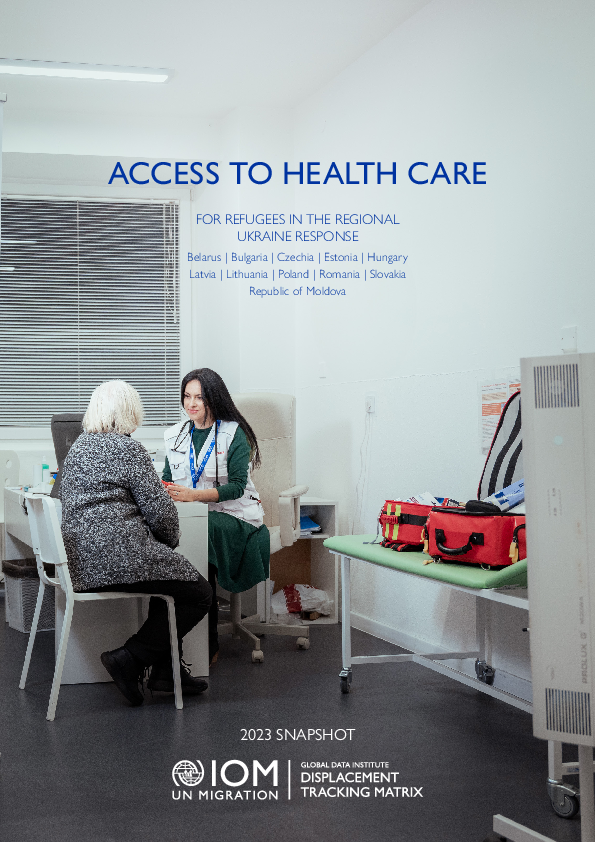-
Countries
-
Data and Analysis
-
Special Focus
-
Crisis Responses
Flow Monitoring
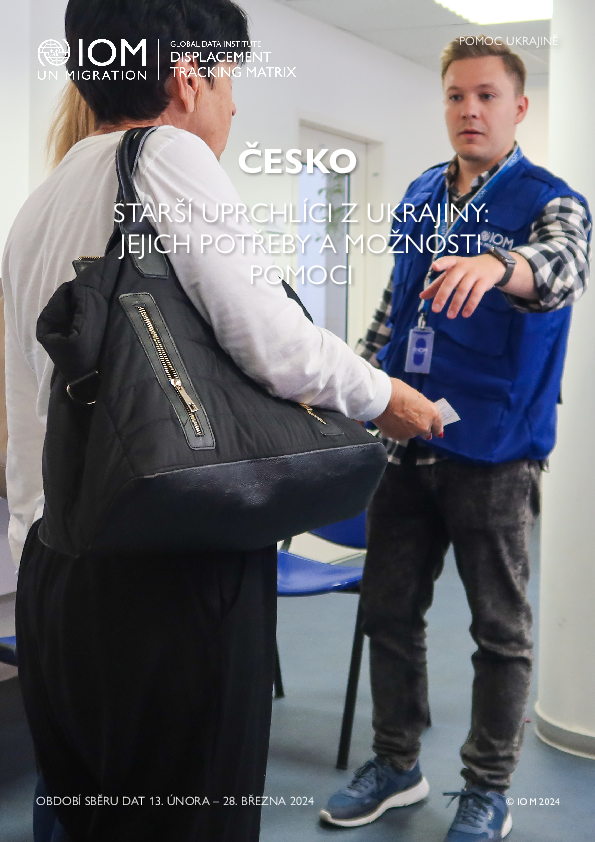
Contact
DTM Europe, DTMMediterranean@iom.int
Language
Czech
Location
Czechia
Period Covered
Feb 13 2024
Mar 28 2024
Activity
- Survey
- Flow Monitoring
K 1. dubnu 2024 bylo v Česku podle vnitrostátních orgánů registrováno 338 736 uprchlíků z Ukrajiny, kteří žádali o dočasnou ochranu. Tato zpráva vychází ze smíšeného výzkumu se staršími uprchlíky, skupinou, která byla v předchozích výzkumech, označena za jednu z nejzranitelnějších. Ukazuje, že ekonomická soběstačnost a jazyková adaptace mohou být pro tyto osoby problematické. V důsledku toho jsou často závislí na vnější podpoře, kterou jim ve většině případů poskytují jejich rodinní příslušníci. Mnozí z nich, bez ohledu na svůj věk, chtějí pracovat a nebýt pro svou rodinu nebo společnost přítěží. To však může být náročné a pouze 12 % z nich má práci. Ti, kteří nepracují, často pečují o děti nebo postižené členy rodiny nebo se snaží být užiteční jiným způsobem. Tento způsob přínosu je potřeba uznat.
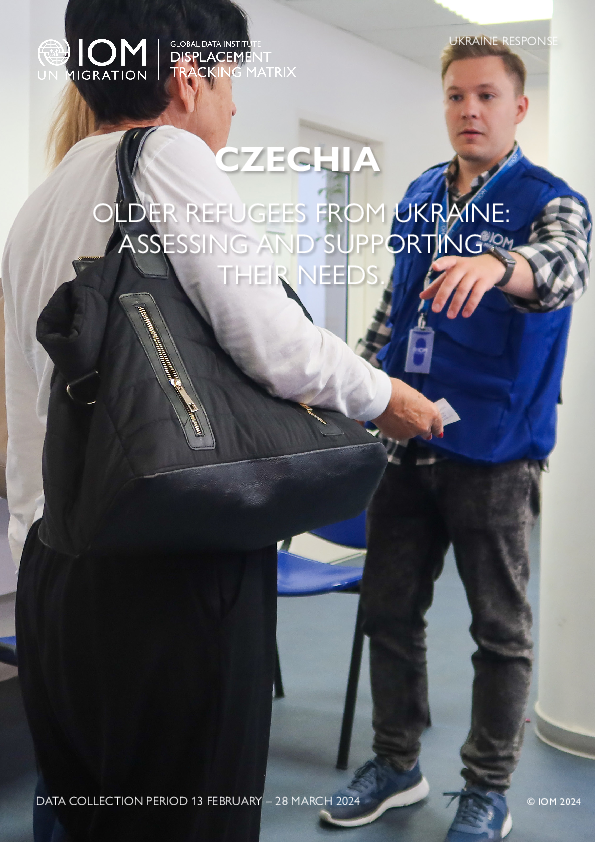
Contact
DTM Europe, DTMMediterranean@iom.int
Language
English
Location
Czechia
Period Covered
Feb 13 2024
Mar 28 2024
Activity
- Survey
- Flow Monitoring
This report is based on a mixed method study conducted among older refugees, a group that has been identified by previous research, including that of IOM, as being among the most vulnerable. It shows that economic self-reliance and language adaptation can be problematic for these individuals. Consequently, they often depend on external support, which in most cases, is provided by their family members. Many of them, regardless of their age, want to work, and not to be a burden to their families or society.
Data collection took place between the dates of 13 February and 28 March 2024, resulting in 403 interviews with refugees from Ukraine. In 128 cases, additional information was collected during the qualitative interview phase.
Key Findings
- 77% of respondents had serious health specific needs
- 73% were registered with a general health practitioner
- Only 12% were employed, where 29% were working without a written contract
- 50% of employed respondents were working 160 hours or more per month
- One-third of respondents could speak Czech (35% of women, 30% of men)
- Over half the respondents couldn’t afford 2,500 CZK as an unexpected expense
- Two-thirds of respondents have a monthly household income of less than 12,500 CZK
- 82% of respondents reported at least one priority need
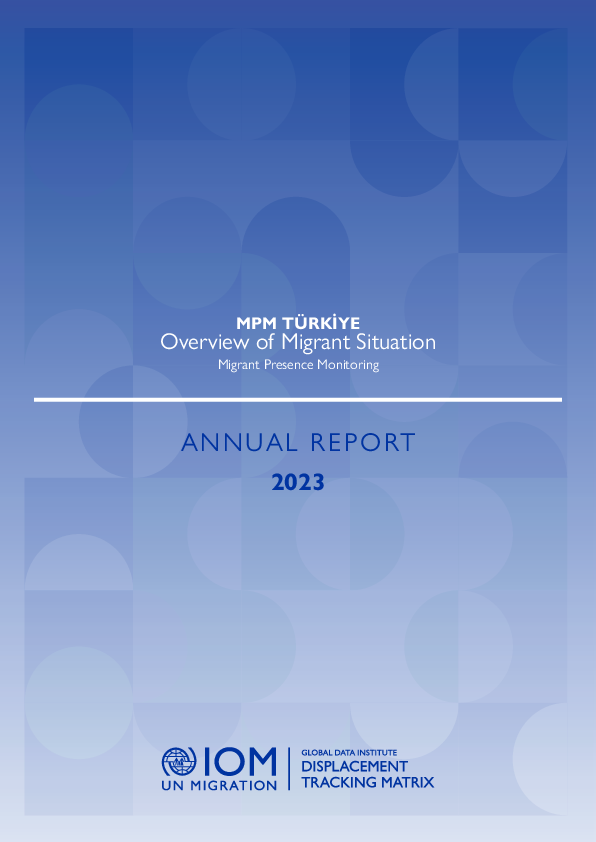
Contact
DTM Türkiye, mpmturkey@iom.int
Language
English
Location
Republic of Türkiye
Period Covered
Jan 01 2023
Dec 31 2023
Activity
- Flow Monitoring
- Migrants presence
According to the latest figures from the Turkish Presidency of Migration Management (PMM), there are more than 4.6 million foreigners in Türkiye, of whom 3.5 million are seeking international protection. Most of them are Syrians (3,214,780 individuals: 3,150,899 urban caseload and 63,881 residing in camps) who have been granted temporary protection status. There is an increase of 16,356 individuals in the number of Syrian nationals staying in camps in comparison to last year's figures.
According to the United Nations High Commissioner for Refugees (UNHCR), there were 296,685 refugees and asylum-seekers in Türkiye as of mid of 2023.
In addition, 1,107,032 foreigners present in Türkiye holding residency permits including short-term residence permit, family residence permit, student residence permit, longterm residence permit, humanitarian residence permit and residence permit for victims of human trafficking.
According to PMM, 254,008 migrants in an irregular situation of different nationalities were apprehended in Türkiye in 2023.4 Please see Page 4 for more details.
From January to December 2023, IOM’s Displacement Tracking Matrix (DTM) collected data on the Needs, Intentions, and Integration Challenges of refugees from Ukraine and Third-Country Nationals (TCNs) in 11 countries in the Ukraine Response: Belarus, Bulgaria, Czechia, Estonia, Hungary, Latvia, Lithuania, Poland, Republic of Moldova, Romania, and Slovakia. Over the course of 2023, a sample of a total of 28,712 respondents were surveyed on displacement patterns and experiences, including access and barriers to health care.
Key Findings
- One-third (34%) of respondents stayed with at least one person (including themselves) with a chronic condition.
- 16% of respondents had or accompanied someone with at least one disability in 2023.
- Across all 11 countries, 54% of the people interviewed faced one or more challenges to accessing health care.
- Top barriers included long waiting times (30%) and the language barrier (23%).
- Top health needs reported were health-care services (41%), medicines (29%) and psychological counselling (5%).
- 37% of households needed to pay for both health-care services and medicine.
- 42% of respondents needed more information on health-care services, 17% on psychological counselling and 12% on medicine.
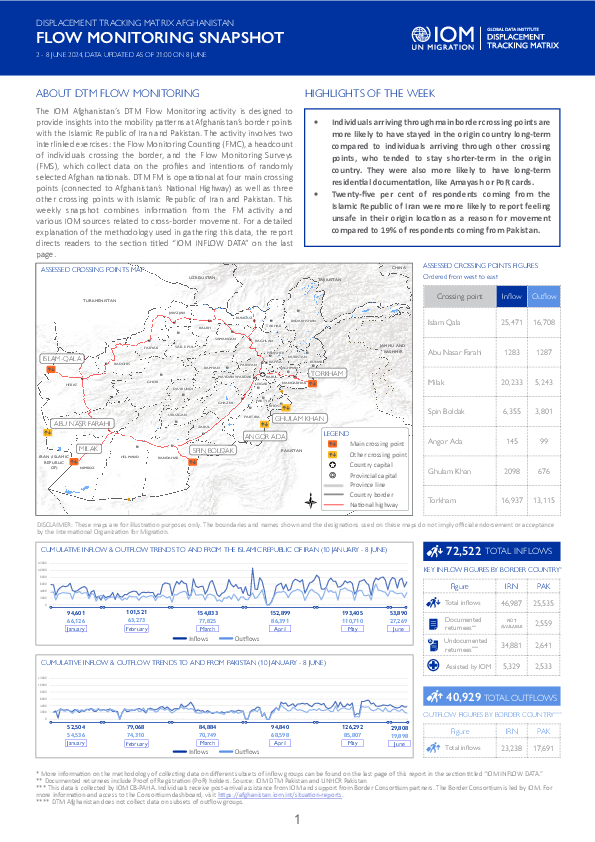
Contact
DTMAfghanistan@iom.int
Language
English
Location
Afghanistan
Period Covered
Jun 02 2024
Jun 08 2024
Activity
- Survey
- Flow Monitoring Survey
- Flow Monitoring
The IOM Afghanistan’s DTM Flow Monitoring activity is designed to provide insights into the mobility patterns at Afghanistan’s border points with the Islamic Republic of Iran and Pakistan. The activity involves two interlinked exercises: the Flow Monitoring Counting (FMC), a headcount of individuals crossing the border, and the Flow Monitoring Surveys (FMS), which collect data on the profiles and intentions of randomly selected Afghan nationals. DTM FM is operational at four main crossing points (connected to Afghanistan’s National Highway) as well as three other crossing points with Islamic Republic of Iran and Pakistan. This weekly snapshot combines information from the FM activity and various IOM sources related to cross-border movement. For a detailed explanation of the methodology used in gathering this data, the report directs readers to the section titled “IOM INFLOW DATA” on the last page.

Contact
DTM Iraq, IraqDTM@iom.int
Language
English
Location
Iraq
Period Covered
Dec 01 2023
Feb 29 2024
Activity
- Survey
- Flow Monitoring Survey
- Flow Monitoring
The Cross-Border Monitoring Report: Protection Risks and Concerns Among Travellers Crossing for Work data on labour-related protection risks among travellers passing through border crossing points monitored by IOM.
The main types of employment for incoming travellers were services, hospitality, and sales (29%); along with factory work (24%); Trained manual worker (15%) and unskilled manual labour (13%). For outgoing travellers, the main types of work were trained manual labour (36%); factory work (18%); Services, hospitality and sales workers (13%) and unskilled manual labour (6%).
The top protection concerns faced by these travellers were the provision of false information by employers regarding the nature of the work and working without receiving the expected payment.

Contact
IraqDTM@iom.int
Language
English
Location
Iraq
Period Covered
Dec 01 2023
Feb 29 2024
Activity
- Survey
- Flow Monitoring
The Cross-Border Monitoring Report presents data collected at border crossing points with neighbouring countries – the Islamic Republic of Iran, the Syrian Arab Republic and Türkiye – to better understand migration movements in the Middle East. The report and dashboard provide an overview of travellers’ movements, their main socio-demographic characteristics, employment status, countries of origin, countries of destination and main reasons for travel.
Between December 2023 and February 2024, Ibrahim al Khalil saw the most traffic with a total of 60,809 travellers and 12,998 vehicles passing through the border crossing point, whilst Fishkhabour saw the least traffic with 19,925 travellers and 1,099 vehicles passing through the border.
UNHCR and IOM Joint Annual Overview 2023
In 2023, an estimated 212,100 attempts were reported by migrants and refugees to cross the Central Mediterranean Sea from Algeria, Libya, and Tunisia to Europe. This was a 33% increase compared to known departures in 2022.
Of those who attempted to depart in 2023, 71% (151,500) were disembarked in Europe, while 29% (60,600) were rescued or intercepted and disembarked in North Africa (21% in Tunisia, 8% in Libya).
In 2023, more than 3,105 migrants and refugees are known to have lost their lives or gone missing at sea while attempting to cross to Europe along the three Mediterranean routes (eastern, central and western Mediterranean), an increase compared to more than 2,500 deaths recorded in 2022. 61% of the deaths in 2023 took place on the central Mediterranean Sea. According to IOM’s Missing Migrants Project, more than 700 deaths occurred off the coast of Tunisia, more than 680 off Libya and more than 460 off Italian shores. The increasing number and proportion of deaths off the coast of Tunisia is unprecedented in the last 10 years. Notably, more than 1,9008 deaths in the central Mediterranean Sea in 2023 were linked to mass shipwrecks involving the loss of more than 20 lives at sea. However, the real number of dead and missing along these routes is believed to be higher as many incidents go unreported or undetected.
Irregular migration is a complex, dynamic and fragmented phenomenon, and remains difficult to fully picture. Strengthening the understanding of migration routes, trends as well as migrant profiles is critical to protect migrants and support evidence-based policies. The International Organization for Migration's Displacement Tracking Matrix (DTM) and Missing Migrants Project (MMP) collect data on the departures, arrivals, deaths and disappearances of migrants along migratory routes.
This document presents the resumption of migration from the coasts of West Africa to the Canary Islands (Spain). This route, already active in 2006, saw an increasing number of movements in 2023, and in the first months of 2024 there were considerable increases compared to the previous year. The risks, deaths and disappearances following shipwrecks are also on the rise along the Atlantic coasts. Between January and March 2024, 13,115 migrants reached the Canary Islands irregularly after crossing by boat from the coasts of West Africa, an increase of 502 per cent compared to 2023 (2,178 migrants).
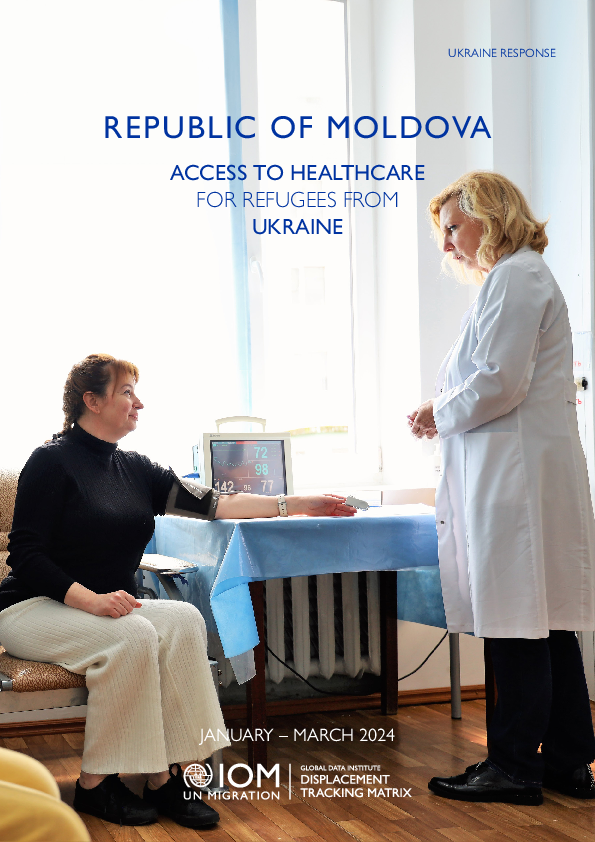
Contact
DTM Europe, DTMMediterranean@iom.int
Language
English
Location
Republic of Moldova
Period Covered
Jan 01 2024
Mar 31 2024
Activity
- Survey
- Flow Monitoring
The IOM’s Displacement Tracking Matrix collected data through Surveys with refugees in the Ukraine Response region from January to March 2024. In the Republic of Moldova, a total of 1,507 surveys were collected. This report focuses on the characteristics, socio-demographic composition, challenges, and needs of the displaced population in the Republic of Moldova, with a particular emphasis on healthcare and the medical needs of the respondents.
Key findings:
- 39% of respondents have or live with people with specific needs or serious medical conditions, while 2% reported living with a pregnant or lactating women.
- Main health issues for women include chronic disease or serious medical conditions (25%), difficulty walking (5%), visual impairment (3%), and hearing impairment (3%).
- Main health issues for men include chronic disease or serious medical conditions (48%), difficulty walking (5%), visual impairment (5%) and hearing impairment (2%).
- Health related needs reported by the respondents include medication (43%), health services (36%), and mental and psychosocial support (2%).
- The most reported barriers to accessing health care were costs (59%), long queues (35%), language barrier (19%), unavailable services (18%), and lack of documents (17%).
Pagination
- Previous page
- Page 6
- Next page
